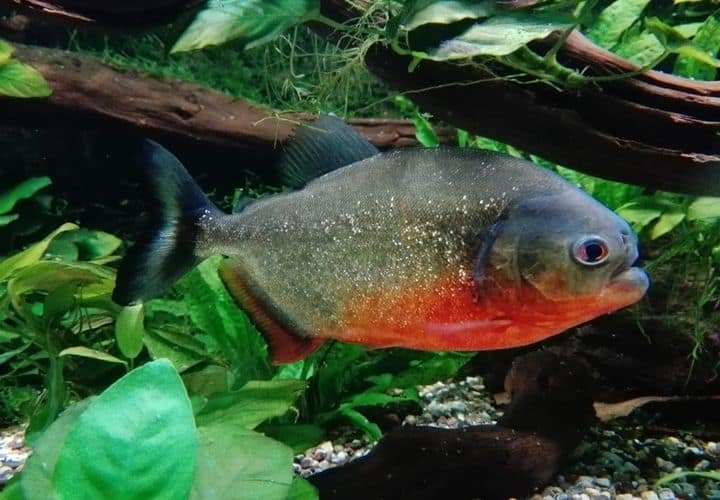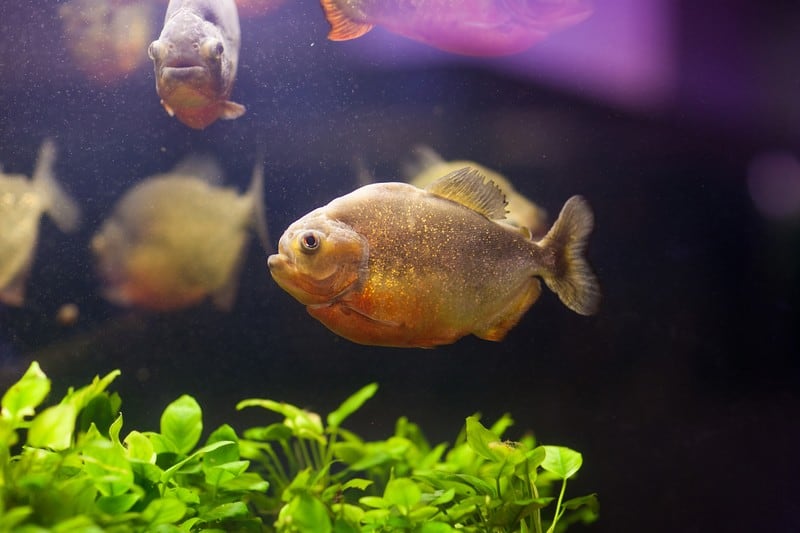Piranhas are freshwater fish species specifically local to South American rivers, floodplains, and lakes. They are characterized by their sharp teeth and frenzied eating habits. Though they are predominantly found in South America, some species also found in some parts of Africa. In the Brazilian language, Piranha actually means “toothfish”.
What do Piranhas Eat? Piranhas eat diets comprising of fish, crustaceans, seeds, carrion, crustaceans, some plants, and worms.
What Do Piranhas Eat in the Rainforest?
Most Piranhas are Carnivorous in the forest, they can consume up to 2.46g of food in a day, which is roughly 1/8th of their body weight at maturity.
Piranhas are known to eat themselves, whether alive or dead. Rainforest Piranhas like the Wimple species will feed on scales of fishes to get their dietary protein sources.
Some Piranhas species are vegetarian in nature, consuming more seeds than other fishes. The Tomatoes camunani, for instance, is a type of Piranhas that is vegetarian in nature.
It is quite strange to know that Piranhas can eat all kinds of worm in the rainforest but they can eat the same in captivity without developing problems. Worms must be processed along with fish flakes or pellets in order to feed Piranhas in captivity.
What Do Piranhas Eat in Captivity?
In captivity, Piranhas will consume fish pellets and flakes, especially those rich in animal components. They can also be fed with mealworms, Earthworms, krill, and some other feeder fishes.
It is important to get Piranhas food from reputable fish feed suppliers only to avoid feeding the fishes with unregulated feed.
The thaw frozen foods are mostly preferred by Piranhas in captivity unless you are raising them under controlled conditions. Do not grab insects and worms from your garden or yard, they can be poisonous to the fish.
More: Piranha vs Pacu
Why Do Piranhas Eat So Fast?
Do you often wonder why Piranhas eat so fast? There are several reasons why Piranhas can strip large animals like a cow, down to pieces.
One of the reasons for this is that Piranhas don’t chew, and when they bite down, the big chunk they remove goes down into their belly. They just bite and snap the jaws while filling their bodies with chunks of food.
Another reason why Piranhas at so fast is because they normally attack large animals in groups. With an average school size of 20, these fishes are efficient team-eaters. They normally indulge in an eating frenzy they will rotate continuously with one piranha taking a bite and leaving the way for another to eat.
When piranhas are starving, they eat more quickly than other fish species.
How Do Piranhas Eat Their Food?
Piranhas are known to eat their food very fast. They can attack any fish smaller than their sizes. They are known to bite at a maximum force of 72 pounds, which is three times their body weight. Piranhas prey on both living and dead animals. They are predominantly Carnivorous in nature.
When Piranhas are very hungry, they go for the eyes and tails of their prey. Such type of attack is very useful for Piranhas because it demobilizes the prey.
Piranhas eat their food quickly, even when they are not hungry. They consume food by swallowing it immediately even though they have the strongest teeth to break food into pieces.
What Else You Should Know About Piranhas
Piranhas can live for between 4 and 15 years. While some of them grow up to 2 inches, they can grow as much as 8 inches in length when fully matured.
- The Redbelly Piranha is one of the smallest species of Piranha you can found, weighing a little more than 3 pounds in adulthood.
- They are known to make a barking sound. The red-bellied Piranhas, for instance, is known for making barking sounds when caught.
- When threatening other fishes, Piranhas are known to make thud or low grunts sound, they do this in conjunction with circling the fish.
- The teeth of these fishes are roughly a quarter of an inch long. The jaw of the fish is designed to chop large pieces of food very fast. The top teeth interlocks with the bottom teeth when the fish snap shut and the jaws are super-strong.
- Experts recommend that temperatures in the tank must remain stable, preferably between 78 and 88 F degree which is the optimal survival temperature for the fish species.
The Juveniles are known to be very fond of playing with aquatic plants. They also enjoy sandy substrates. Make sure the bottom is filled with sufficient sand and few rocks, in addition to water plants. Some driftwood can offer some place of rest for the adults.
Piranha is easily attracted to blood. Never dip your hand into the tank to feed the fishes, they bite sharply and blood drips can cause them to migrate to the surface, fast. They can even swim so powerful enough to jump out of the water.
Feeding You Piranhas
The Juvenile Piranhas must be fed up to 4 times a day. The growing adults should be fed up to twice a day. Fully matured Piranhas should be fed at least once in a day or every 2 days.
Feeding should be stopped if there are leftovers in the tank, and efforts must be made to remove leftovers and change 25% of water immediately.
It is equally important to begin feeding your Piranhas slowly to see how it adjusts or accept the feed type, then you can increase it slowly over the next few days. Avoidance of a particular feed means the fish will require an alternative. Try as much as possible to stick to the feed type offered to the fish by the original owners.
Raising the Piranha in the Aquarium
Piranha is one of the fish species you must not raise with other fish species because of their aggressive nature.
It is possible to raise a school of Piranha fishes (not more than 20), however, you need to ensure that they don’t starve. Piranhas are known to attack themselves when they starve. This, however, does not mean they must be overfed.
You need to start by choosing a large tank. Piranhas need lots of moving around, hence you should choose a tank that provides enough room for them.
Piranhas can live up to 20 years, even in captivity. An adult Piranha will require up to 100 Gallon tank and an additional 20 gallons for each new Piranha added to the tank. It is important to add some tank decorations because Piranhas love to hide among them.
Piranhas are freshwater fish, they prefer a pH range of between 6.5 and 7.5. a number of factors can sharply increase or decrease pH levels inside the aquarium. For instance, foods rich in Nitrates can increase acidity quickly causing the pH to drop quickly, while ammonia-rich foods can increase alkalinity, causing a spike in the pH levels.
In most cases, remnants of foods and a high level of fecal deposits of the fish can cause a rapid change in pH levels. For this reason, it is important to replace at least 25% of the water in the tank with a fresh one every day, to keep the pollution levels down.
Though the recommended feeding for juveniles is 4 times daily, while adults can be fed once or twice a day, it is important to check physically any leftover foods to avoid over-feeding.
There should be no more than 2 Piranhas in a 50 -gallon tank, if you are raising a school of 20 Piranhas, then you need to have at least a 250-gallon tank.
You need to ensure a closed-monitoring on a school of Piranhas, to ensure that they don’t attack themselves.
When it comes to breeding, Piranhas are not excellent breeders though they can produce up to a dozen fries at the same time. The fries must be transferred into another tank to avoid the adult Piranhas eating them alive.
Feeding-related Diseases and Protecting Your Fish
Piranhas are susceptible to a number of parasitic and bacterial diseases, especially when they are fed live foods. Earthworms and insects from your garden, for instance, can cause serious health issues to the fish, making them slow down their activities significantly.
When your piranhas are always withdrawn and don’t respond to feeding, as usual, you need to have it examined at the veterinary for sicknesses.
Though you must not conclude that the cause of sickness is food-related. When pH gets extremely low or high, your fish may be affected badly. If you notice the fish scratching its body against tank decorations, you should try and replace as much of the water as possible, immediately.


